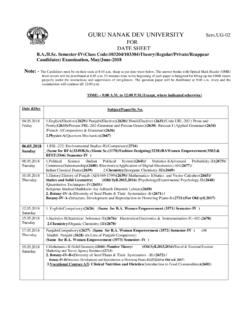Transcription of Introduction to MySQL - TCD
1 Chapter 1 Introduction to MySQLA oife Conventions in this documentCommands to be entered on the UNIX/Linux command line are preceded byunixprompt>and those to be entered on the MySQL prompt are preceded bymysql>. UNIX commands are case sensitive whereas MySQL commands (exceptpasswords) are The MySQL interfaceOne simple (in terms of its appearance and capabilities) way of accessing MySQLis through the standard interface. To enter the MySQL interfaceunixprompt> MySQL -u wbyeats -pEnter password: MySQL >The -u tag precedes the username, and the -p tag invokes the passwordprompt.
2 To log in as any other user replace the username commands are then typed on the MySQL command line. The end ofeach command is defined by a semicolon ;. Once you have entered the mysqlinterface you can select a database to look at (with theusecommand) and useany MySQL queries to read, edit, or add > use tissueinfo; MySQL > show tables;+-----------------------------+| Tables_in_tissueinfo |+-----------------------------+| gene_map || gene_info |+-----------------------------+ MySQL > quit1 CHAPTER 1.
3 Introduction TO Basic MySQL administration toolsUsually only the root user has permission to create new databases and new usersfor the MySQL server. The MySQL user is independent of any other means that an individual may use more than one MySQL username. Toenter the MySQL interface as root:unixprompt> MySQL -u root -pEnter password: MySQL > Create a MySQL databaseIt is easy to create a new MySQL table within the MySQL > CREATE DATABASE tissueinfo; Users, passwords, and privilegesWe now have an empty database, but we don t yet have any users to access thisdatabase.
4 To simultaneously create a user, assign a password, and grant accessto this newly created database enter: MySQL > GRANT USAGE ON tissueinfo.* to wbyeats@localhostIDENTIFIED BY ode2maud ;This creates the user wbyeats if it doesn t already exist, and sets the passwordto ode2maud . Note that if the user wbyeats already exists the passwordwill be set to ode2maud (even if the password was previously set to somethingdifferent). This statement also grants wbyeats access to all of the tables withinthe tissueinfo database (specified by tissueinfo.)
5 * ).One of the attractive features of MySQL is the strict security it gives yourdata. The tradeoff is some extra work for the database administrator, becauseaccess privileges must be individually set. Granting usage only allows the userto log in to the database, but not to actually look at the data or enter any grant these privileges the root user must also specify: MySQL > GRANT SELECT, INSERT ON tissueinfo.* to wbyeats@localhostIDENTIFIED BY ode2maud ;Which gives wbyeats permission to look at data (SELECT) and to add new data(INSERT).
6 If you trust wbyeats you can grant all possible permissions (includ-ing permission to delete any data in the database) with the simple statement:CHAPTER 1. Introduction TO MYSQL3mysql> GRANT ALL ON tissueinfo.* to wbyeats@localhostIDENTIFIED BY ode2maud ; Account settings: . you are frequently using MySQL through the unix commands or the mysqlinterface then the requirement to specify username and password every timequickly becomes tedious. Within UNIX/Linux you can write these parametersinto a file called.
7 In your home directory. This file should contain yourusername and password information in exactly the following format.[client]user=wbyeatshost=localhos tpassword=ode2maudMySQL will automatically read this information when you are using the MySQLinterface or system commands (at the UNIX prompt), but not when connectingto the MySQL database from within a Perl script (see later). This means youdo not need to specify-u wbyeats -pwhen executing commands. For the restof this document the commands will be written as if this file is in place.
8 If it isnot you will need to add the-u wbyeats -pparameters to the command MySQL database structureMySQL databases consist of a(ny) number of tables. Tables hold the are made up of columns and rows. A user that has been givenCREATEandDROP permissions on a database can create and remove tables of that TABLE command simultaneously creates the table and defines itsstructure (although the structure of the table can later be changed using theALTER TABLE command). ColumnsA table consists of several columns each of which has a specific data type ( ,integer, text).
9 It is useful to define columns correctly because it has implicationsfor sorting the data (numeric versus text) and for the size of an allowed elementin the column. Column types include:INT integerFLOAT Small floating-point numberDOUBLE Double-precision floating-point numberCHAR(N) Text N characters long (N= )VARCHAR(N) Variable length text up to N characters longTEXT Text up to 65535 characters longLONGTEXT Text up to 4294967295 characters longCHAPTER 1.
10 Introduction TO Creating tablesTheCREATE TABLE command can either be entered at themysql>prompt orcan be written into a file and sent into MySQL later. The latter is preferablebecause you retain a record of how created the table. A table may be createdas follows:DROP TABLE IF EXISTS gene_map;CREATE TABLE gene_map (gene VARCHAR(255) NOT NULL,chromosome INT NOT NULL,cM_position FLOAT NOT NULL,id INT NOT NULL AUTO_INCREMENT,);This creates a table calledgene_mapwith four columns:gene,chromosome,cM_position,id.






